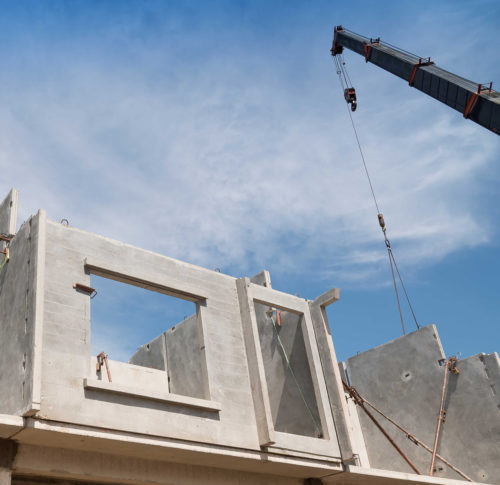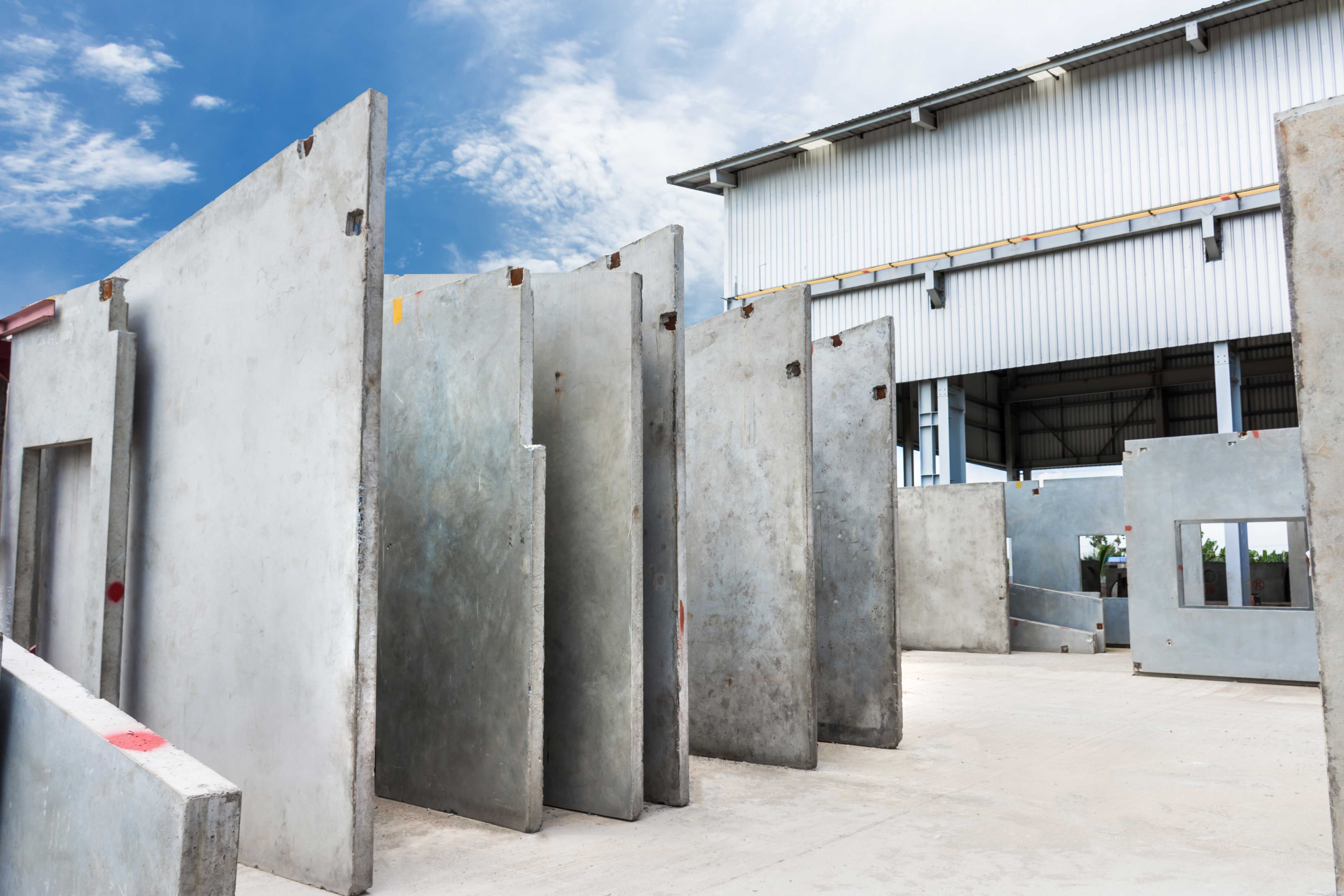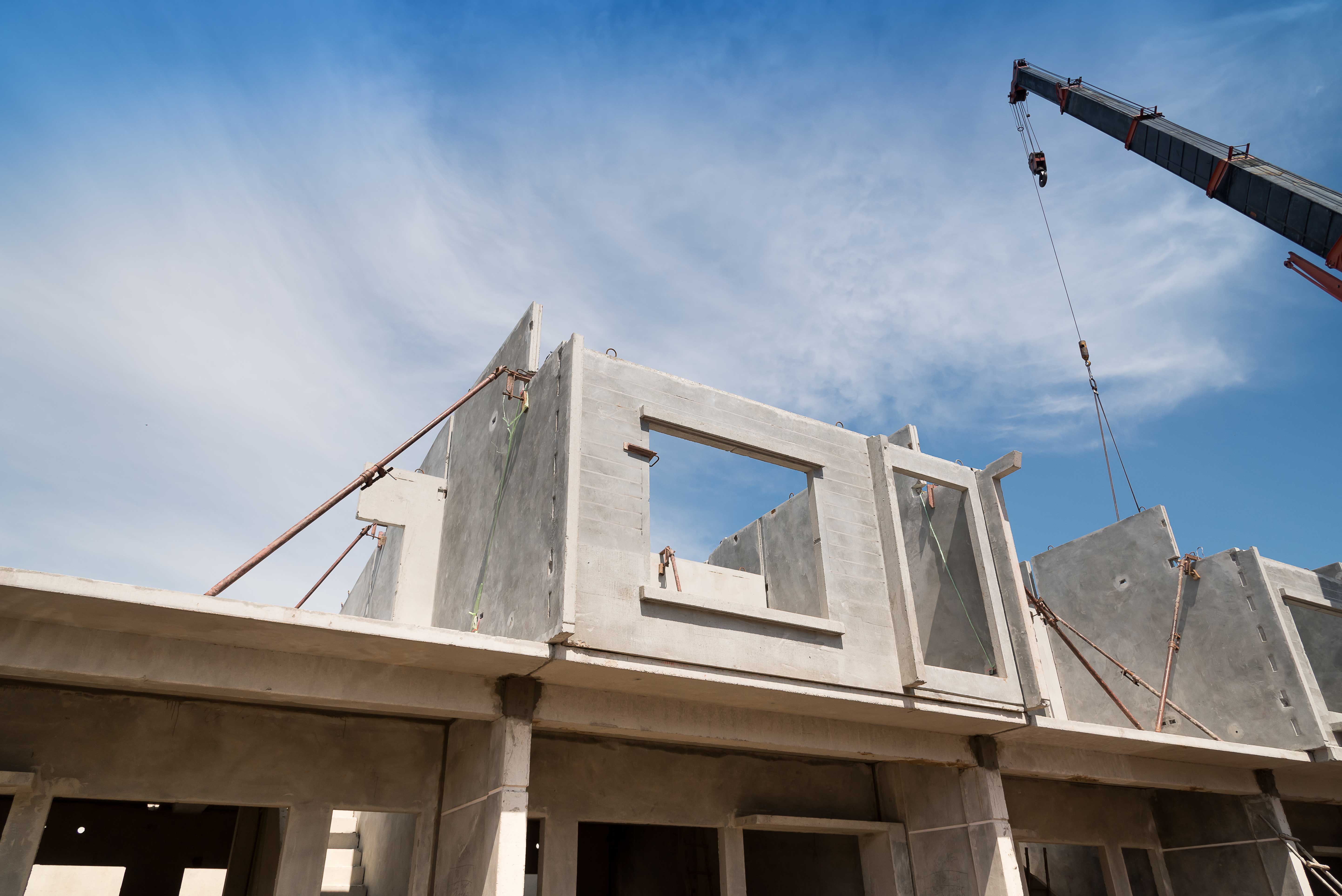What began as a trend to cope with labor market shortages has become a permanent fixture in the building industry.
But what exactly is prefabrication?
How does it support the industry?
Is it worth the investment?
What changes are required in the building process when incorporating prefabricated designs?
While prefabrication may not always be the right solution,
its many advantages make it an appealing option in the industry.
WHAT IS PREFABRICATION?
Prefabrication is the overarching term that describes the components of a project built off-site and delivered as a complete unit to the job site. An example on the small end of the scale is a ready-to-install electrical outlet, complete with hardware and wiring—also called “pre-assembled” prefabrication. The larger end could include pre-built hotel rooms shipped as boxes (or modules), walled in, wired and containing most finishes. They can then be stacked into a hotel tower.
It’s a common misconception to call the entire project prefabricated or not prefabricated. Often only portions of a project are prefabricated; however, in the future, it’s possible that most of a building will be constructed off-site and then fully assembled on-site.
IS PREFABRICATION DIFFERENT THAN MODULAR CONSTRUCTION?
You may have heard the term “modular” used in the industry. This refers to repetitive, prefabricated “modular” designs that are built off-site then pieced together on the building site. When most of the building is composed of these “modules,” the building is typically referred to as a modular building.

WHY IS THIS METHOD OF BUILDING SO POPULAR NOW?
Industry publications have started regularly featuring prefabrication in headline stories. As with any new technology, there are growing pains. Thanks to consistent improvements and efficiency gains, recent reports have shown an increase in the practice. There are a few factors that have played a large role in transforming prefabrication from a trend into an industry staple.
Success Stories. 2015, Beijing posted a time-lapse video of a highway bridge restoration that was completed in 43 hours. After the old bridge was demolished and removed piece by piece, one giant prefabricated panel with four lanes seamlessly slid into the former bridge’s place(8). This method avoids the time and cost of months or years of closing off lanes and avoids creating dangerous conditions for workers near moving traffic. Though this bridge goes above and beyond most examples of the practice, prefabricated scopes of work and modular projects are typically completed 30-50% faster than conventional methods(1). Successful projects engage the masses by inspiring with the art of what’s possible and push the market towards adaptation.
The Recession. About two million construction workers were laid off between 2007-2011(7). As the economy rose, demand an immediate need for infrastructure rose as well. Unfortunately, most skilled workers who had lost their jobs in the recession had either retired or moved into another field. Suddenly, no labor force was available to complete construction projects, forcing the industry to get creative. Lean practices like prefabrication were inserted into every step of the process, mitigating the cost of wasted material and minimizing physical labor requirements. Today, the practice requires 15-16% less labor than traditional methods, and an even greater reduction in on-site labor(12).
Sustainability. Sustainable building has become an industry staple, with multiple building certifications and tax advantages available to incentivize owners to build more eco-friendly structures. Prefabrication not only reduces waste, but companies are getting creative and recycling unique products and leveraging the concepts of prefabricated design. Shipping containers, for example, have become a popular product for building both temporary and permanent structures.


ARE THERE CHALLENGES?
A 2017 report on the worldwide use of Prefabrication showed 6.9% annual growth. Only a year later, the growth trend seemed to be slowing, with only a 5.9% increase in adoption. For a trend receiving notable praise in industry media, these numbers and their adoption are relatively low. With the perceived hype and potential, what accounts for this slowing growth?
Cost. According to a 2017 study on prefabrication in China, prefabricated parts costs on average 10-20% more than their on-site built counterparts. This is due to a variety of factors, including management, labor, off-site real estate and machinery, molds, and materials. Project owners need to work closely with their design team and builder during the early stages of cost-estimating to evaluate their project holistically. This will help identify areas where an expedited schedule, or overall cost-savings, could justify the additional cost of using prefabricated parts, and make the practice worth the investment.
Clashes between designer and builder. As with any new process, there are barriers to entry and kinks to be smoothed out. For instance, a contractor’s desire to save money and time with prefabrication can collide with an architect’s desire to create something unique. Since prefabrication often relies on repetitive components in a design, a designer may feel it limits their creative vision. Prefabrication is new, and many of its processes are still being finetuned, creating potential cost, schedule and safety risks in construction for an inexperienced contractor. These scenarios often surface for both the contractor and design team, encouraging both to adhere to methods they’re used to.
To really reap the benefits of prefabrication, it is imperative that an owner engage the design team and builder during the planning phase, before and during design, to evaluate and agree upon the components of the project best suited for prefabrication.
Quality. Because prefabrication is still in its infancy, it lacks many codes and standards. Time is often of the essence in using this practice, and quick production with few recognized standards can be a formula for creating compromised products. Some prefabricated products also have a reputation for poor quality, i.e. weak joints and poorly insulated panels often don’t perform to usual standards. Though these issues will be mitigated with time and experience, owners and entire project teams need to take extra steps through thorough evaluations of manufacturers and prefabrication methods to identify the right solutions, especially during this transitional period in the industry.
WHERE IS THIS PRACTICE UTILIZED MOST?
The Asia-Pacific market is currently leading the world’s implementation of prefabricated infrastructure. A rapidly growing middle-class population has instigated an immediate demand for residential, commercial and road construction. The Chinese government has pumped a significant percentage of their GDP into prefabricated bridges and roads, delivering some of the most complex projects in record time. With Tokyo hosting the upcoming Olympic games in 2020 there is an intense demand for building facilities, hotels, and infrastructure in a tight time frame. Prefabrication can be a solution to help meet ambitious deadlines.
TODAY’S BIGGEST TRENDS:
Steel
In modular construction, buildings are typically constructed with steel frame, cold form steel wall panels and hot rolled steel framework, making steel the most used material in prefabricated scopes of work and modular buildings(4). Reports on future trends anticipate steel will remain the key player going into 2024 as this practice grows worldwide (though tariffs could have an impact on the United States).
Bathroom Pods(5)
In 2018, the prefabricated bathroom pods market was estimated to total $700M. The pods are a type of modular prefabrication and are a walled-in bathroom, complete with required plumbing systems, toilet accessories, and finishes: though pods can vary in size and complexity. Pods can be easily shipped and moved around once on-site. They are also ideal for taller buildings and can be quickly installed by crane. Most bathrooms require a variety of trade contractors to work around one another, but pod installation requires few trade team members to completely install the product once it is placed. It is estimated the pods will continue to grow in demand and to make up close to $1.2B in market share by 2025.

Flex Space
Buildings are now frequently built to have many different uses. The growth in mixed-use buildings and flexible space requires easy to assemble and disassemble building design. Modular designs are often just as easy to move around and rearrange as they are to install. Many residential facilities and hotels take this approach if their tenants are only temporary or their tenants will be mobile, requiring modular facilities that travel well. Higher education classrooms are utilizing prefabricated laboratories or MEP components to quickly adapt to changes in technology, allowing their space to more easily change and evolve with state-of-the-art designs.
Corporate Involvement
Many corporations are investing in or absorbing prefabrication firms to support their corporate building goals, allowing them to deliver first-hand research in this new building process. The investment also has internal benefits, as it allows large companies to build quick, affordable housing for their people living in expensive markets.
Google(11) – In 2017, Google invested $30 million for short-term housing using modular construction from the firm Factory OS. This initial investment for 300 units allowed Google employees to find short-term housing in an otherwise expensive San Francisco market. Since its inception, Google has expanded its interest in modular construction.
Autodesk & Citi(2) – Following Google’s investment, Autodesk and Citi both invested in Factory OS to expand on the practice’s technology and meet their internal housing demands. Their undisclosed investment will go into a new factory dedicated to modular construction. Autodesk also invested in a construction software company, BuildingConnected, a tool focused on streamlining the construction process used by over 700,000 construction professionals.
Please be advised that this whitepaper is an educational and informational resource only. The views and statements expressed herein are not to be construed as legal advice from the authors or IMA and such communication is not protected under the attorney client privilege. Recipients should seek specific legal advice from competent legal counsel of your choice.
SOURCES AND NOTES:
2. AUTODESK INVESTING IN PREFAB https://www.greenbiz.com/article/why-autodesk-investing-urban-prefab-construction-startup
3. FORBES RISE OF PREFAB BUILDING https://www.forbes.com/sites/bisnow/2017/08/02/the-rise-of-the-prefabricated-building/#254c47731dd5
4. Markets and Markets on Modular Construction Market report 2017: https://www.marketsandmarkets.com/PressReleases/modular-construction.asp
5. Prefab Bathrooms https://cryptofirstnews.com/2019/10/07/prefabricated-bathroom-pods-market-will-surge-at-5-7-cagr-to-reach-1133-million-us-by-the-end-of-2025/
6. Prefab Housing Market Report https://www.prnewswire.com/news-releases/global-prefabricated-housing-market-trends-forecast-and-competitive-analysis-2019-2024-with-profiles-of-algeco-scotsmankirby-building-systems-skyline-lindal-cedar-homes-butler-manufacturing-300928787.html
7. Automation in Construction https://www.ehstoday.com/safety-technology/increasing-automation-construction-industry
8. Factors Affecting the Capital Cost of Prefabrication—A Case Study of China\ However, prefabrication was hindered by many barriers that are involved in the engineering construction process [15]. As a new method, the technical issues of prefabrication are likely to bring about some quality problems, such as weak performance of joint nodes [16] and poor thermal insulation performance of precast facades [8]. Prefabrication lacks standards and specifications, especially for the design, production and installment processes, and thus is affiliated with various problems, such as mismatching of precast components (PC), on- and off-site components and incapability of mass production [17–19]. Furthermore, the capital cost of prefabrication has been estimated 10–20% higher than on-site construction [20]. Specifically, a survey revealed that the capital cost of the prefabrication was CNY200–300/m3 higher than that of the on-site construction in China [7]. Most of the project clients take cost factors into account when they choose a construction method [21], and 85% of the clients refused to adopt prefabrication because of the higher capital cost [22]. Meanwhile, the contractors might not take prefabrication if the price remains higher than traditional on-site [23]. Financial incentives were implemented to buffer the impact of higher capital cost, such as tax allowance, floor area bonus, cash allowance [16], etc. in China. However, prefabrication was still at its infancy stage, and the preferential policies had only a temporary promotion, and has not resulted in a sustainable increase in the use of prefabrication. Previous studies have revealed that the higher capital cost was still the most significant barrier to the prefabrication development [24]. Factors affecting prefabrication promoting have been explored while the significance of these factors and the potential to improve prefabrication project management have been reported. Meanwhile, the benefits of the whole life cost of prefabrication have been discussed. The inscape of prefabrication cost has been analyzed and classified. However, few studies have explored the causes of incremental capital cost of prefabrication compared to traditional on-site construction, especially for the process-oriented (consisting of three main process: design, production and transportation and installation processes) and object-oriented cost management strategies (including main stakeholders, e.g., clients, designers, supervisors, contractors and PC manufacturers; refers to labor, materials, machinery consumption). The cost of prefabrication has been anecdotal or fragmented with isolated studies. Hence, this study aims to explore factors affecting the incremental capital cost of prefabrication compared to traditional on-site construction through a questionnaire survey and interviews. The research objectives of this study are to explore the causes of incremental capital cost of prefabrication systematically; rank the relative significance of the factors; propose process-oriented and object-oriented cost management strategies; and examine how cost management is affected by the “experience”, “corporate responsibility”, and “participant function” as fix independent factors.
NOTE: Both reports state steel is primary material. NOTE: The 2017 report estimated 6.9% and 2018 reported 5.7%. Note the decrease in growth as part of realizing the issues with prefab.
9. https://dbia.org/wp-content/uploads/2018/06/Design-Build-Market-Research-FMI-2018.pdf
10. https://www.youtube.com/watch?v=vz_j_BEkVCQ
11. https://factoryos.com/press/future-of-affordable-housing/
12. Capital Cost Optimization for Prefabrication: A Factor … – MDPIhttps://www.mdpi.com › pdf
